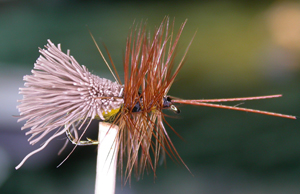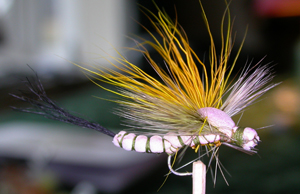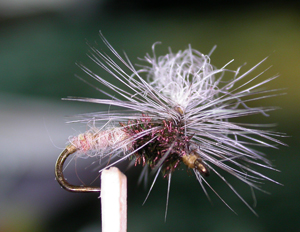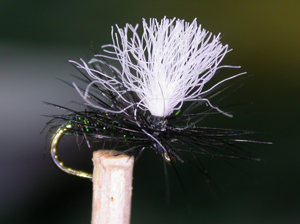I’m sure most of us are aware that certain fly patterns work extremely well on some rivers and not very well on others. Hence, the idea behind this page is to create a list of patterns that work well on the Cod Beck for some anglers. Currently the opinions and flies will be those of your chairman and will be only those he has caught fish on. This probably means you should not take too much notice of them 🙂
Ideally we would love some feedback from other members about what worked for them and when. Was there a hatch on at the time? If members wish to send us a description of their favourite flies, how to fish them, and a good quality photo, we would be very pleased to add them to the list. If you do not have a photo, send us an example of the fly and we will do it for you. Any flies sent can be returned, or raffled off during the AGM.
My usual searching dry-fly/emerger is a klinkhammer in various colours and sizes, black, tan or olive being good colours; in sizes 14 down to 18 or smaller. Small black flies of many types are particularly succesful. We seem to have a lot of small black flies around the Beck. Anyone approaching the hawthorn bushes near the first kissing gate on the way to the Caravan site will know what I mean, I don’t think these are the classic hawthorn flies as they are very small, but I could be wrong.
I have seen the surface of the Beck covered with them (I presume it was them), very small 18-22 or smaller. A good imitation is shown here, tied by Michael Weeks. He told me on a day when he could see no fish rising this little black beauty took nearly 20 fish to just over a pound in a few hours. So well worth fishing something black when all looks dead.
When Caddis are around an excellent  imitation is the Deer Hair Caddis dry-fly as originally tied by John Goddard. It is a very good pattern on the beck, for me at least. It is pretty much unsinkable, which helps and I often use this as my “Klink” when fishing the “Klink and Dink” (see general advice page) when I see Caddis flying around.
imitation is the Deer Hair Caddis dry-fly as originally tied by John Goddard. It is a very good pattern on the beck, for me at least. It is pretty much unsinkable, which helps and I often use this as my “Klink” when fishing the “Klink and Dink” (see general advice page) when I see Caddis flying around.
Of course when Mayfly are around , and it’s usually obvious when they are. You should see the spinners floating downstream like galleons with their wings upraised, catching the breeze and skittering them left and right.
Trout can often be seen leaping out of the water in their eagerness to grab the egg laying females. You may also wonder where the Hell all those trout have suddenly appeared from.
As they say make hay whilst the sun shines.
I think anything large and vaguely off white in colour will work, I know people who swear by a grey duster as a Mayfly imitation. Shown is one those complicated Oliver Edwards Variation called a Mohican Mayfly. It works exceedingly well, again qualified by the “for me at least”.
I hope these pages give any newcomers a little bit more confidence in their fly choices for the Beck. But as I’ve said on the nymph page, the fish are not fussy in their fly choice……usually!


